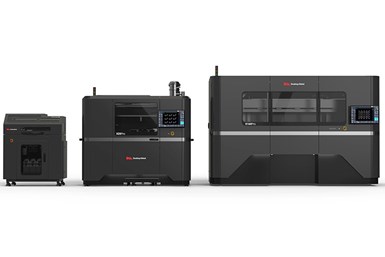USNC Acquires Two Desktop Metal Printers for Nuclear Energy Solutions
The printers are said to 3D print advanced materials such as silicon carbide (SiC) — a technical ceramic with extreme environmental stability often used in aerospace, armor, plasma shield and high-temperature applications.

The X-Series of binder jetting systems are said to 3D print advanced materials such as silicon carbide (SiC) — a technical ceramic with extreme environmental stability often used in aerospace, armor, plasma shield and high-temperature applications. Photo Credit: Desktop Metal
Ultra Safe Nuclear Corporation (USNC), a developer of Micro Modular Reactor (MMR) systems for the production of safe, commercially competitive, clean and reliable nuclear energy, has acquired two Desktop Metal 3D printers. The printers are from the recently updated X-Series line of binder jetting systems and the company says it has plans to acquire two additional machines later this year.
Desktop Metal’s X-Series line of binder jet 3D printing systems for metal and ceramic powders includes the InnoventX, X25Pro and X160Pro. The company says these printers can 3D print advanced materials such as silicon carbide (SiC) — a technical ceramic with extreme environmental stability often used in aerospace, armor, plasma shield and high-temperature applications.
According to the company, USNC transforms highly pure, crystalline, nuclear-grade SiC into the shapes and forms that can safely surround a nuclear fuel particle, enabling USNC’s fully ceramic micro-encapsulated (FCM) fuel innovation. It is said the technology is a key component of USNC’s fuel design for use in a new generation of advanced reactors.
“Binder jetting is a low-cost, high-yield, reliable process for our complex serial production. The advanced material capability of the X-Series machines is fundamental to our innovative approach to fuel design,” says Dr. Kurt A. Terrani, executive vice president of USNC’s Core Division. He previously led multiple research and development efforts at Oak Ridge National Laboratory.
The X-Series line was designed to scale applications from research and development to mass production with repeatable open parameters and performance across a range of machines. With the small-format InnoventX already installed at the company’s facility in Salt Lake City, Utah, USNC has developed its next-generation nuclear fuel matrix to be scaled up on the larger X25Pro and X160Pro systems.
“Driving mass adoption of additive manufacturing requires scalable systems capable of printing high-performance materials that enable the most innovative applications,” said Ric Fulop, co-founder and CEO of Desktop Metal. “We’re proud to support the mission of USNC with flexible binder jetting technology that takes customers all the way to production and helps play a role in solving global-scale problems with additive manufacturing solutions.”
Related Content
-
3D Printed Titanium Replaces Aluminum for Unmanned Aircraft Wing Splice: The Cool Parts Show #72
Rapid Plasma Deposition produces the near-net-shape preform for a newly designed wing splice for remotely piloted aircraft from General Atomics. The Cool Parts Show visits Norsk Titanium, where this part is made.
-
Why AM Leads to Internal Production for Collins Aerospace (Includes Video)
A new Charlotte-area center will provide additive manufacturing expertise and production capacity for Collins business units based across the country, allowing the company to guard proprietary design and process details that are often part of AM.
-
“Mantis” AM System for Spacecraft Uses Induction for Deposition
The metal 3D printing system melts wire without lasers. 30-foot-diameter parts are built on a rotary-feed system that eliminates the need for a large machine frame or gantry.













